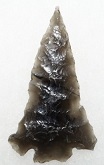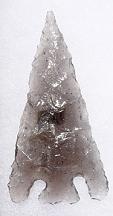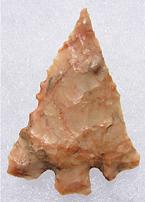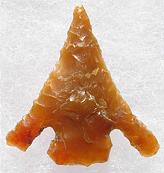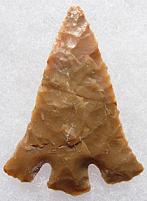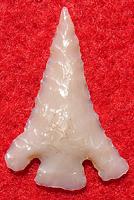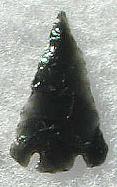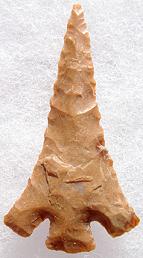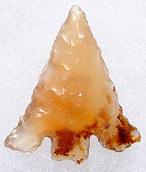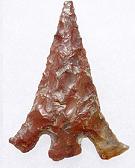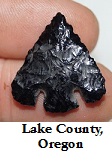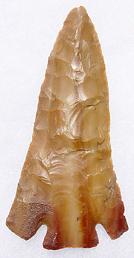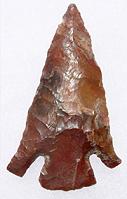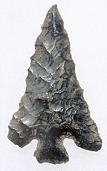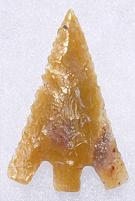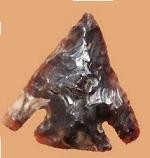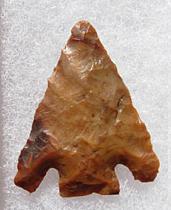Outline is Representative of Size and Shape:

Name Details:
Identified By: Robert F. Heizer and M. A, Baumhoff
Named For: Type Site
Date Identified: 1961
Type Site: Eastgate Cave, Churchill County, Nevada
Identified By: Robert F. Heizer and M. A, Baumhoff
Named For: Type Site
Date Identified: 1961
Type Site: Eastgate Cave, Churchill County, Nevada
Point Validity:
Valid type
Heizer was an eminent anthropologist and a professor at the University of California – Berkley. Heizer was influential in promoting our understanding of the archaeology of California and Nevada. Baumhoff was a distinguished anthropologist and serves as the Chair in the Department of Anthropology, University of California – Berkley. He conducted extensive studies into the archaeology of California. This type was named in a professional publication and has many professional references. This is considered a valid type.
Heizer was an eminent anthropologist and a professor at the University of California – Berkley. Heizer was influential in promoting our understanding of the archaeology of California and Nevada. Baumhoff was a distinguished anthropologist and serves as the Chair in the Department of Anthropology, University of California – Berkley. He conducted extensive studies into the archaeology of California. This type was named in a professional publication and has many professional references. This is considered a valid type.
Eastgate Barbed
AKA: RosegateCluster: Rosegate Cluster
Description of Physical Characteristics and Flaking Pattern:
This is a small triangular basal notch point with a flattened cross section. The blade is commonly thin and may vary from slightly excurvate to incurvate. The blade usually flares out at the shoulders edge. The shoulders are barbed and are generally squared, but may become pointed when the blade is re-sharpened. The barbs commonly extend to the base of the point. The stem is most commonly expanding, but may range to straight. The base may range from straight to convex. This point is commonly well made and has a random flaking pattern.
Size Measurements:
Total Length - 16 to 61 mm (average 33 to 43mm), Stem length - 4 to 6 mm, Blade Width - 14 to 35 mm (average 20 to 25 mm), Stem Width (at shoulders) - 5 to 9 mm, Thickness - 3 to 6 mm.
Total Length - 16 to 61 mm (average 33 to 43mm), Stem length - 4 to 6 mm, Blade Width - 14 to 35 mm (average 20 to 25 mm), Stem Width (at shoulders) - 5 to 9 mm, Thickness - 3 to 6 mm.
Commonly Utilized Material:
Additional Comments:
These point represent the first true arrow point and the transition to the bow and arrow technology in the Great Basin (Justice, 2002).
David H. Thomas (1981) combined the Rose Springs type and the Eastgate types into a single type due to the overlapping characteristics of the two types. He used a contracture of the two points and formed the Rosegate Cluster.
This point is similar to the Rose Springs point, but the Rose Springs type lacks the square barbs typically seen on the Eastgate points. This point is usually wider than the Rose Springs points. Placement of the notches also differ between the two types. The Eastgate type have notches that enter from the base of the point so the entire length of the blade is present where Rose Springs have the notch enter the blade low on the blade to the corner of the blade shortening the length of the original preform blade. Both types are the extension of the Elko Corner Notch type, but evolved to better fit the change in technology from the dart points to the arrow points. Desert series points and Cottonwood points replaced this type of point (Justice, 2002).
Homer and Weder (1980) place the date of this point at 500 - 800 A.D. in the Great Basin which is before the appearance of the Parowan type point. It is thought that this point may have evolved into the Parowan type point.
These point represent the first true arrow point and the transition to the bow and arrow technology in the Great Basin (Justice, 2002).
David H. Thomas (1981) combined the Rose Springs type and the Eastgate types into a single type due to the overlapping characteristics of the two types. He used a contracture of the two points and formed the Rosegate Cluster.
This point is similar to the Rose Springs point, but the Rose Springs type lacks the square barbs typically seen on the Eastgate points. This point is usually wider than the Rose Springs points. Placement of the notches also differ between the two types. The Eastgate type have notches that enter from the base of the point so the entire length of the blade is present where Rose Springs have the notch enter the blade low on the blade to the corner of the blade shortening the length of the original preform blade. Both types are the extension of the Elko Corner Notch type, but evolved to better fit the change in technology from the dart points to the arrow points. Desert series points and Cottonwood points replaced this type of point (Justice, 2002).
Homer and Weder (1980) place the date of this point at 500 - 800 A.D. in the Great Basin which is before the appearance of the Parowan type point. It is thought that this point may have evolved into the Parowan type point.
Distribution: 

Distribution Comments:
This point is found through-out the Great Basin and into the northern Colorado Plateau. This point has a northern border of the Snake River Plain, an eastern border of the Colorado River valley, a western boarder of Death Valley and eastern California.
This point is found through-out the Great Basin and into the northern Colorado Plateau. This point has a northern border of the Snake River Plain, an eastern border of the Colorado River valley, a western boarder of Death Valley and eastern California.
Age / Periods:
Date: 1,500 - 1,100 B.P.
Cultural Period:Late Prehistory - Developmental
Glacial Period: Roman Warm to Vandal Minimum
Culture: Fremont, Anasazi , Shoshone Culture
Date: 1,500 - 1,100 B.P.
Cultural Period:Late Prehistory - Developmental
Glacial Period: Roman Warm to Vandal Minimum
Culture: Fremont, Anasazi , Shoshone Culture
Age Details:
Other points in this cluster / Related / Associated Points:
Eastgate Expanding Stem, Eastgate Split Stem, Parowan Basal Notch, Rose Springs Corner Notch, Rose Springs Side Notch, Rose Springs Stemmed
Eastgate Expanding Stem, Eastgate Split Stem, Parowan Basal Notch, Rose Springs Corner Notch, Rose Springs Side Notch, Rose Springs Stemmed


